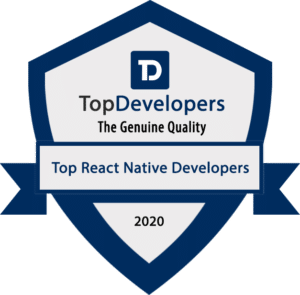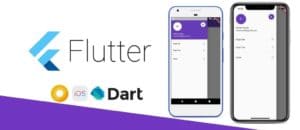React Native or Flutter? What to choose
January 14th, 2020
React Native with JavaScript and Flutter with mysterious Dart – two multi-platform app development technologies creating rumors and gossips. In this article, we will cross-check both in detail from a devs’ and clients’ viewpoint.
Businesses are searching for an opportunity to develop mobile applications, both for iOS and Android, with flashing activity and fewer sources. Certainly, Apple and Google have implemented original techs to create apps. Android engineers use Kotlin/Java when iOS app developers work with Xcode and Swift. Yet, this enforces coders to discover two totally different technologies. As a consequence, corporations have started to use cross-platform solutions to create apps for both iOS and Android using a special language.
So still, our clients and partners questioned about which framework to choose for your app? Which tech stack gives the fastest time-to-market? What to choose ReactNative or Flutter to develop an app?
We’ve summarized a whole bunch of answers in this article, so you can gain an advantage from them as well.
React Native
React Native is a technology originated by Facebook in 2015. Flutter, a technology originated by Google, has been profoundly promoting since 2017. Despite the fact that Flutter is a young framework, it already has 74 k stars on GitHub. So far React Native has almost 81 k stars. React Native is an open-source framework that uses JavaScript language. With React Native you can create applications for both Android and iOS applying one codebase. A bunch of modern applications like Instagram, Pinterest, Skype, Wix are built with React Native.
React Native development: benefits
- Hot Reload
Hot Reload quickens the creating process by providing an engineer entering the original code right into a working app. So, a coder can detect changes immediately, without refurbishing the app. Hot Reload also holds the application’s condition, bypassing the threat of missing it through a full update (a significant advantage in the meaning of state-based frameworks) – fast-tracking app development even more. - Maturity
The React Native announcement was 5 years ago, so the Facebook team has had lots of time to maintain the API, as well as fix bugs and explain difficulties. Additionally, React Native is a “member” of the “React family”. Which means they all run over both web and mobile platforms. - A powerful and large community
React Native has a huge coder community, therefore there are innumerable lessons, libraries, and UI frames that make it accessible and simple to discover the tech – just as much as it is fast and clear to develop. If we confront reps on GitHub about specific technologies, React Native is much more extensive than Xamarin or Flutter. - Easy to learn
The current profit on our table is deeply focused on React developers. If you have experience in web development and work with modern React stack, you can effortlessly handle React Native without the necessity to learn new libraries.
React Native development: disadvantages
- Not really Native
Similar to every cross-platform stack, not the UI, not UX not fulfillment would be equal to native apps – just similar to them. But still, it is simpler to perform a “native sense” with React Native than with Flutter. - Limited components
React Native contains only major elements outside the borders. However, there are external repositories with many extra elements for React Native. An engineer is allowed to use it but that demands extra work and time.
Flutter
Flutter is Google’s UI toolkit for building beautiful, natively compiled applications for mobile, web, and desktop from a single codebase. Flutter apps are created in the Dart language and use many of the language’s more high-level characteristics.
Flutter development: benefits
- One code for two apps
Flutter is a cross-platform solution that works flawlessly with the established widget sets for customizing UI design. Now Google is engaged in creating Flutter for Web. - Perfect UI
Flutter doesn’t lean on native custom elements. Flutter has its own collection of custom widgets provided and maintained by the frame’s visuals engine. Applications made with Flutter have an especially user-friendly UI: a crucial benefit for Flutter above React Native is the terrifically detailed attention to the visual aspects. Flutter allows you to easily create your personal widgets, or adjust a current widget. - Performance
Developers seldom confront concerns while running React Native hybrid application structure, Whereas Flutter performs more simple for developers, as they can reuse the current code. - Documents and Toolkit
Documentation preparation is highly complicated and prolonged. Nevertheless, Flutter is really great at facilitating the app developer’s work and enabling them to document their applications. The documentation method with React Native is not as prepared.
Flutter development: disadvantages
- Application size
Applications written in Flutter are bigger than native ones. In general, it’s 20% more heavy than, for example, React Native based app. - Newness
Flutter is still pretty new. This means you couldn’t possibly always get the functionality you want in current libraries, so engineers may need to develop personal functionality, which can cause delays.
What to choose for your app: React Native or Flutter?
The cross-platform type of Flutter and React Native decreases launch-time. Additionally, external libraries and plug and play elements make it more useful for building a mobile application. These two tech stacks allow more than rapid development, they can decrease operating expenses as well.
So if your developers are pretty familiar with Dart, feel free to choose Flutter for your new app, however, if they not – it takes time to learn it, so it will be logical to pick the React Native. If you want to develop an MVP for your app – let’s say, to demonstrate for possible funders – Flutter is an excellent choice, primarily if you have a limited amount of time.
You always have to explain and describe your project for a skilled team of developers: professionals able to analyze the several approaches, with a different experience when it appears to cross-platform development. Here at KitRUM, we build business applications for clients applying the tech that is most beneficial – whether it be Flutter, React Native or Native IOS and Android. Since 2014, we’ve been building Native and cross-platform apps for Healthcare, Financial, Automotive, Agriculture and Retail industries.














